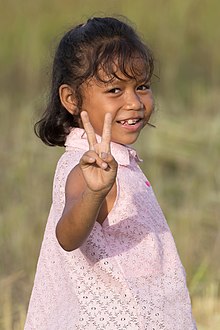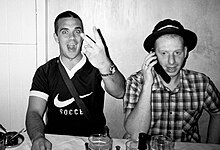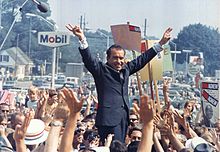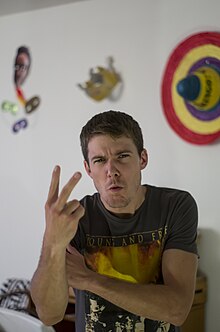V sign

The V sign is a hand gesture in which the index and middle fingers are raised and parted to make a V shape while the other fingers are clenched. It has various meanings, depending on the circumstances and how it is presented.
When displayed with the palm inward toward the signer, it can be an offensive gesture in some Commonwealth nations, dating back to at least 1900. The more widespread use as a victory sign ("V for Victory"), with the back of the hand toward the signer (U+270C ✌ VICTORY HAND in Unicode), was introduced in January 1941 as part of a campaign by the Allies of World War II.[1] During the Vietnam War, in the 1960s, the "V sign" with palm outward was widely adopted by the counterculture as a symbol of peace and still today in the United States it is commonly called the "peace sign." Shortly thereafter, it also became a gesture associated with fun used in photographs, especially in East Asia, where the gesture is also associated with cuteness.
Usage[]



The meaning of the V sign is partially dependent on the manner in which the hand is positioned:
- If the palm of the hand faces the signer (i.e., the back of the hand faces the observer), the sign can mean:
- An insulting gesture in Australia, the Republic of Ireland, New Zealand, South Africa[citation needed] and the United Kingdom.[2][3]
- The number '2' in American Sign Language.
- With the back of the hand facing the signer (palm of the hand facing the observer), it can mean:
- The number '2'.
- Victory – in a setting of wartime or competition. It was first popularised in January 1941 by Victor de Laveleye, a Belgian politician in exile, who suggested it as a symbol of unity in a radio speech and the subsequent "V for Victory" campaign by the BBC.[4] It is sometimes made using both hands with upraised arms as United States President Dwight Eisenhower and, in imitation of him, Richard Nixon, used to do.
- Peace, or friend – used around the world by peace and counter-culture groups; popularized in the American peace movement of the 1960s. The commonality with the symbol's use from the 1940s was its meaning the "end of war".[5]
- V (the letter) – used when spelling in American Sign Language.[6]
- When used with movement, it can mean:
- Air quotes – flexing fingers, palm out, one or both hands.[7]
- This hand shape is also used in a number of signs in many sign languages, including (in American Sign Language) "to look" (with the palm down) or "to see" (palm up). When the pointer and middle fingers are pointed at the signer's eyes then turned and the pointer finger is pointed at someone it means "I am watching you."[8]
- The ordinal "second" in American Sign Language has the V-sign palm forward, then the hand turns (yaws) until the palm faces backward.[9]
As an insult[]

The insulting version of the gesture (with the palm inward U+1F594